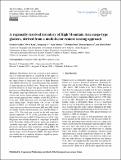Files in this item
A regionally resolved inventory of High Mountain Asia surge-type glaciers, derived from a multi-factor remote sensing approach
Item metadata
| dc.contributor.author | Guillet, Gregoire | |
| dc.contributor.author | King, Owen | |
| dc.contributor.author | Lv, Mingyang | |
| dc.contributor.author | Ghuffar, Sajid | |
| dc.contributor.author | Benn, Doug | |
| dc.contributor.author | Quincey, Duncan | |
| dc.contributor.author | Bolch, Tobias | |
| dc.date.accessioned | 2022-03-10T15:30:09Z | |
| dc.date.available | 2022-03-10T15:30:09Z | |
| dc.date.issued | 2022-02-18 | |
| dc.identifier | 278226728 | |
| dc.identifier | b554ce8b-5f01-4b7c-b3b2-ce5403b2471f | |
| dc.identifier | 85125269157 | |
| dc.identifier | 000760276000001 | |
| dc.identifier.citation | Guillet , G , King , O , Lv , M , Ghuffar , S , Benn , D , Quincey , D & Bolch , T 2022 , ' A regionally resolved inventory of High Mountain Asia surge-type glaciers, derived from a multi-factor remote sensing approach ' , Cryosphere , vol. 16 , no. 2 , pp. 603-623 . https://doi.org/10.5194/tc-16-603-2022 | en |
| dc.identifier.issn | 1994-0416 | |
| dc.identifier.other | RIS: urn:82199AC02AC33366274F1EE09D9E10FC | |
| dc.identifier.other | ORCID: /0000-0002-3604-0886/work/109766311 | |
| dc.identifier.other | ORCID: /0000-0002-8201-5059/work/109766876 | |
| dc.identifier.uri | https://hdl.handle.net/10023/25026 | |
| dc.description | Funding: This study was supported by the Strategic Priority Research Programs of the Chinese Academy of Sciences (grant nos. XDA20100300 and XDA19070202) and the Swiss National Science Foundation (200021E_177652/1) within the framework of the DFG Research Unit GlobalCDA (FOR2630). | en |
| dc.description.abstract | Knowledge about the occurrence and characteristics of surge-type glaciers is crucial due to the impact of surging on glacier melt and glacier-related hazards. One of the super-clusters of surge-type glaciers is High Mountain Asia (HMA). However, no consistent region-wide inventory of surge-type glaciers in HMA exists. We present a regionally resolved inventory of surge-type glaciers based on their behaviour across High Mountain Asia between 2000 and 2018. We identify surge-type behaviour from surface velocity, elevation and feature change patterns using a multi-factor remote sensing approach that combines yearly ITS_LIVE velocity data, DEM differences and very-high-resolution imagery (Bing Maps, Google Earth). Out of the ≈95000 glaciers in HMA, we identified 666 that show diagnostic surge-type glacier behaviour between 2000 and 2018, which are mainly found in the Karakoram (223) and the Pamir regions (223). The total area covered by the 666 surge-type glaciers represents 19.5% of the glacierized area in Randolph Glacier Inventory (RGI) V6.0 polygons in HMA. Only 68 glaciers were already identified as "surge type" in the RGI V6.0. We further validate 107 glaciers previously labelled as "probably surge type" and newly identify 491 glaciers, not previously reported in other inventories covering HMA. We finally discuss the possibility of self-organized criticality in glacier surges. Across all regions of HMA, the surge-affected area within glacier complexes displays a significant power law dependency with glacier length. | |
| dc.format.extent | 21 | |
| dc.format.extent | 14280906 | |
| dc.language.iso | eng | |
| dc.relation.ispartof | Cryosphere | en |
| dc.subject | GB Physical geography | en |
| dc.subject | QE Geology | en |
| dc.subject | DAS | en |
| dc.subject | MCC | en |
| dc.subject.lcc | GB | en |
| dc.subject.lcc | QE | en |
| dc.title | A regionally resolved inventory of High Mountain Asia surge-type glaciers, derived from a multi-factor remote sensing approach | en |
| dc.type | Journal article | en |
| dc.contributor.institution | University of St Andrews. School of Geography & Sustainable Development | en |
| dc.contributor.institution | University of St Andrews. Environmental Change Research Group | en |
| dc.contributor.institution | University of St Andrews. Bell-Edwards Geographic Data Institute | en |
| dc.identifier.doi | https://doi.org/10.5194/tc-16-603-2022 | |
| dc.description.status | Peer reviewed | en |
This item appears in the following Collection(s)
Items in the St Andrews Research Repository are protected by copyright, with all rights reserved, unless otherwise indicated.

